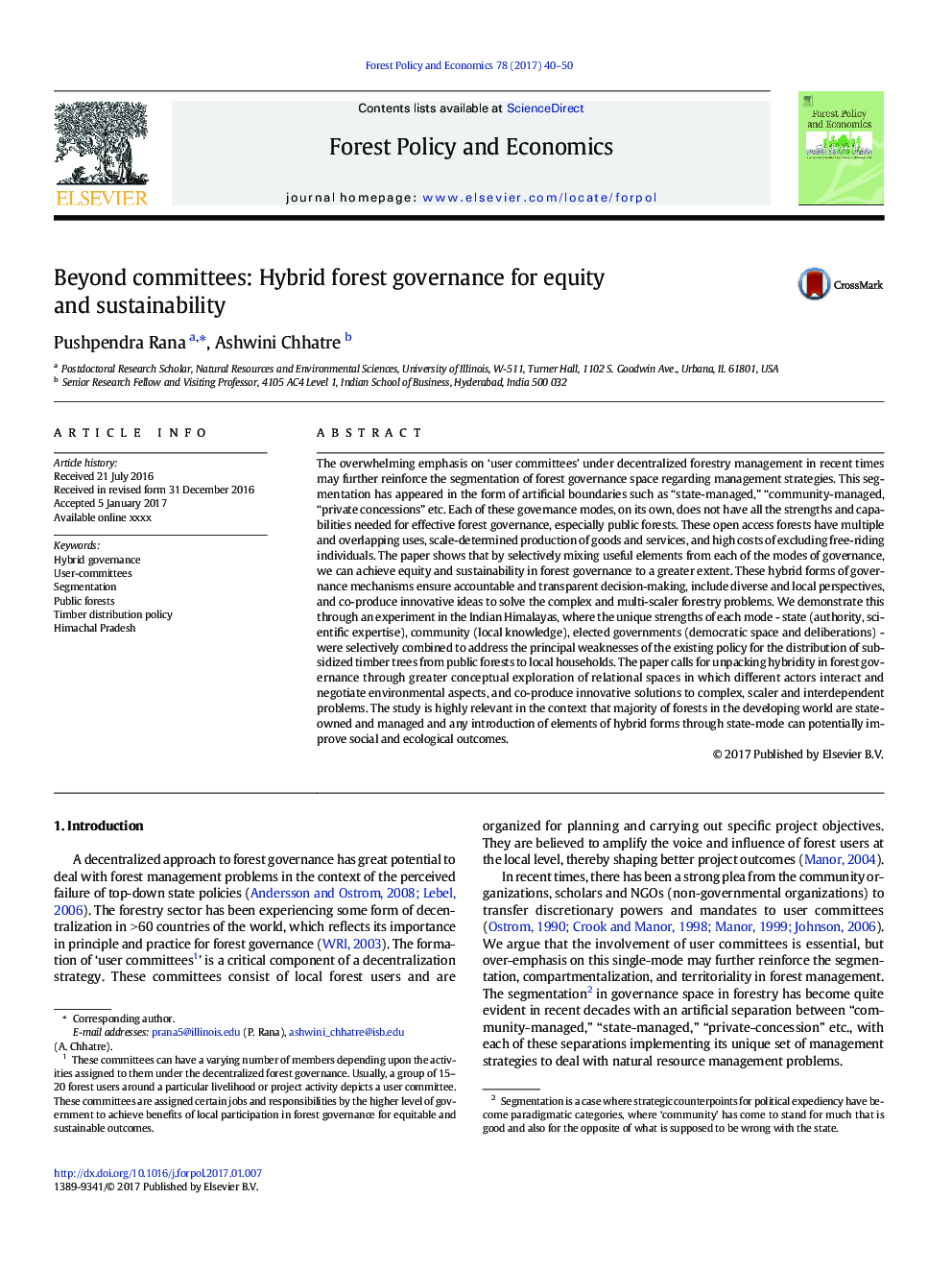| کد مقاله | کد نشریه | سال انتشار | مقاله انگلیسی | نسخه تمام متن |
|---|---|---|---|---|
| 4759766 | 1421661 | 2017 | 11 صفحه PDF | دانلود رایگان |
عنوان انگلیسی مقاله ISI
Beyond committees: Hybrid forest governance for equity and sustainability
ترجمه فارسی عنوان
فراتر از کمیته ها: اداره جنگل ترکیبی برای عدالت و پایداری
دانلود مقاله + سفارش ترجمه
دانلود مقاله ISI انگلیسی
رایگان برای ایرانیان
کلمات کلیدی
اداره هیبرید، کمیته های کاربر، تقسیم بندی، جنگل های عمومی سیاست توزیع چوب، هیمچال پرادش،
ترجمه چکیده
تاکید قاطع بر "کمیته های کاربر" تحت مدیریت غیرمتمرکز جنگلداری در زمان های اخیر می تواند تقسیم بندی فضای اداره جنگل را در مورد راهبردهای مدیریتی تقویت کند. این تقسیمبندی به صورت مرزهای مصنوعی مانند یک دولت اداره شده است؟ یک انجمن تحت مدیریت، یک شرکت خصوصی؟ و غیره. هر یک از این حالتهای حکومتی به تنهایی، تمام توانایی ها و توانایی های لازم برای حکمرانی جنگل های مؤثر، به خصوص جنگل های عمومی ندارد. این جنگلهای دسترسی بازاریابی چندگانه و همپوشانی، تولید محصولات کالا و خدمات تعیین شده در مقیاس و هزینه های بالا برای حذف افراد آزاد است. این مقاله نشان می دهد که با انتخاب ترکیبی از عناصر مفید از هر یک از شیوه های حکومتداری، ما می توانیم در حوزه مدیریت جنگل به میزان قابل ملاحظه ای دست یابیم. این اشکال ترکیبی از سازوکارهای حکومتی، تصمیم گیری های پاسخگو و شفاف را تصدیق می کنند، شامل دیدگاه های متنوع و محلی، و همکاری تولید ایده های نوین برای حل مسائل پیچیده و چندزمانه جنگلداری است. ما این را از طریق یک آزمایش در هیمالیا هند نشان می دهیم، جایی که نقاط قوت منحصر به فرد هر حالت - ایالتی (اقتدار، تخصص علمی)، جامعه (دانش محلی)، دولت های منتخب (فضای دموکراتیک و مشاغل) - به طور انتخابی به نقاط ضعف اصلی از سیاست موجود برای توزیع درختان درخت یارانه از جنگل های عمومی به خانوارهای محلی. این مقاله برای بازتولید مفاهیم در حوزه جنگل ها از طریق بررسی اجمالی مفهومی فضاهای ارتباطی که در آن بازیگران مختلف در تعامل با جنبه های زیست محیطی و مذاکره با آنها مشارکت می کنند، و همکاری تولید راه حل های نوآورانه برای پیچیده سازی، پیچیدگی و مشکلات متقابل وابسته را فرا می خواند. این مطالعه بسیار متناقض در این زمینه است که اکثریت جنگل های در حال توسعه در کشورهای در حال توسعه دولتی و مدیریت می شوند و هر گونه معرفی عناصر فرم های ترکیبی از طریق حالت دولت می تواند به طور بالقوه نتایج اجتماعی و زیست محیطی را بهبود بخشد.
موضوعات مرتبط
علوم زیستی و بیوفناوری
علوم کشاورزی و بیولوژیک
جنگلداری
چکیده انگلیسی
The overwhelming emphasis on 'user committees' under decentralized forestry management in recent times may further reinforce the segmentation of forest governance space regarding management strategies. This segmentation has appeared in the form of artificial boundaries such as “state-managed,” “community-managed, “private concessions” etc. Each of these governance modes, on its own, does not have all the strengths and capabilities needed for effective forest governance, especially public forests. These open access forests have multiple and overlapping uses, scale-determined production of goods and services, and high costs of excluding free-riding individuals. The paper shows that by selectively mixing useful elements from each of the modes of governance, we can achieve equity and sustainability in forest governance to a greater extent. These hybrid forms of governance mechanisms ensure accountable and transparent decision-making, include diverse and local perspectives, and co-produce innovative ideas to solve the complex and multi-scaler forestry problems. We demonstrate this through an experiment in the Indian Himalayas, where the unique strengths of each mode - state (authority, scientific expertise), community (local knowledge), elected governments (democratic space and deliberations) - were selectively combined to address the principal weaknesses of the existing policy for the distribution of subsidized timber trees from public forests to local households. The paper calls for unpacking hybridity in forest governance through greater conceptual exploration of relational spaces in which different actors interact and negotiate environmental aspects, and co-produce innovative solutions to complex, scaler and interdependent problems. The study is highly relevant in the context that majority of forests in the developing world are state-owned and managed and any introduction of elements of hybrid forms through state-mode can potentially improve social and ecological outcomes.
ناشر
Database: Elsevier - ScienceDirect (ساینس دایرکت)
Journal: Forest Policy and Economics - Volume 78, May 2017, Pages 40-50
Journal: Forest Policy and Economics - Volume 78, May 2017, Pages 40-50
نویسندگان
Pushpendra Rana, Ashwini Chhatre,
